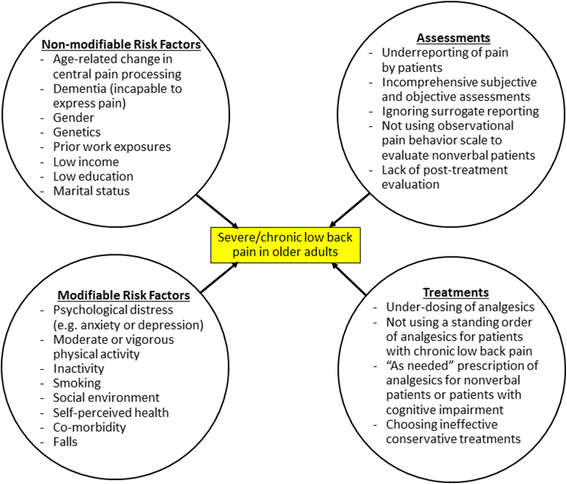Low back pain in older adults: risk factors, management options and future directions
- PMID: 28435906
- PMCID: PMC5395891
- DOI: 10.1186/s13013-017-0121-3
Low back pain in older adults: risk factors, management options and future directions
Abstract
Low back pain (LBP) is one of the major disabling health conditions among older adults aged 60 years or older. While most causes of LBP among older adults are non-specific and self-limiting, seniors are prone to develop certain LBP pathologies and/or chronic LBP given their age-related physical and psychosocial changes. Unfortunately, no review has previously summarized/discussed various factors that may affect the effective LBP management among older adults. Accordingly, the objectives of the current narrative review were to comprehensively summarize common causes and risk factors (modifiable and non-modifiable) of developing severe/chronic LBP in older adults, to highlight specific issues in assessing and treating seniors with LBP, and to discuss future research directions. Existing evidence suggests that prevalence rates of severe and chronic LBP increase with older age. As compared to working-age adults, older adults are more likely to develop certain LBP pathologies (e.g., osteoporotic vertebral fractures, tumors, spinal infection, and lumbar spinal stenosis). Importantly, various age-related physical, psychological, and mental changes (e.g., spinal degeneration, comorbidities, physical inactivity, age-related changes in central pain processing, and dementia), as well as multiple risk factors (e.g., genetic, gender, and ethnicity), may affect the prognosis and management of LBP in older adults. Collectively, by understanding the impacts of various factors on the assessment and treatment of older adults with LBP, both clinicians and researchers can work toward the direction of more cost-effective and personalized LBP management for older people.
Keywords: Brain; Disc degeneration; Elderly; Falls; Genetics; Low back pain; Management; Pain assessment; Risk factors; Spine.
Figures
References
-
- DoEaSA UN. World population ageing 2009. New York: United Nations Publication; 2010.
-
- Greengross S, Murphy E, Quam L, Rochon P, Smith R. Aging: a subject that must be at the top of world agendas. BMJ. 1997;315:1029. doi: 10.1136/bmj.315.7115.1029. - DOI
Publication types
LinkOut - more resources
Full Text Sources
Other Literature Sources
Medical
Research Materials
Miscellaneous

